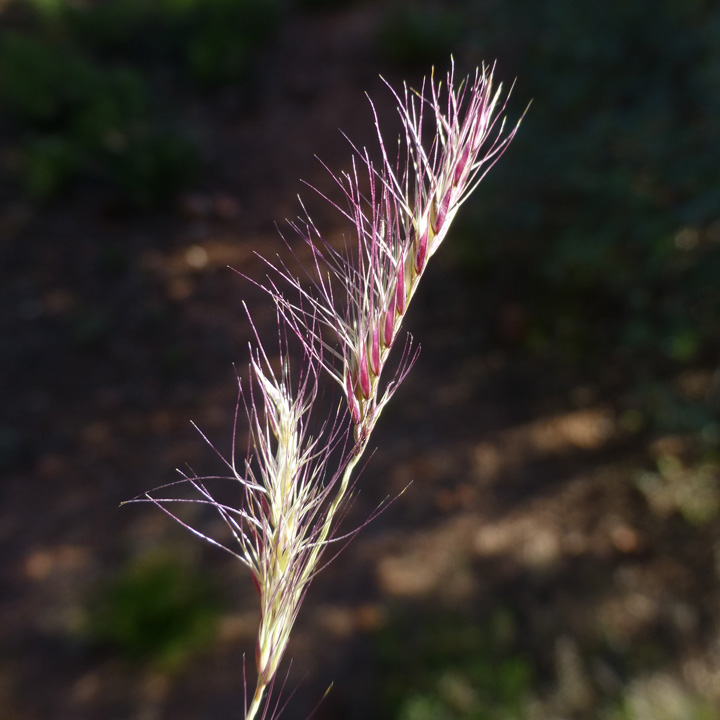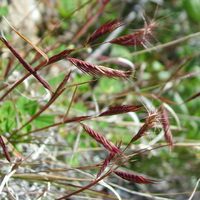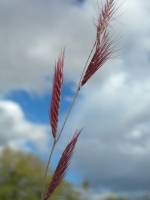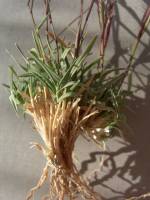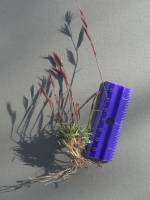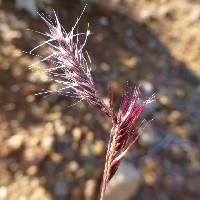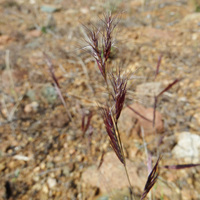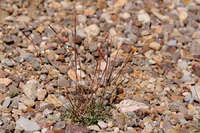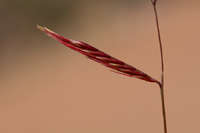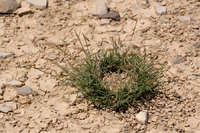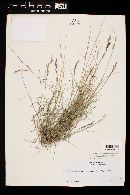|
|
|
|
Family: Poaceae
red grama, more...red grama
[Bouteloua trifida var. burkii (Scribn. ex S.Watson) Vasey, moreChondrosum trinii E.Fourn.] |
Plants perennial; cespitose, older plants occasionally shortly rhizomatous. Culms 5-40 cm, slender, wiry, erect or slightly geniculate at the lower nodes; lower internodes glabrous, shorter than those above. Leaves mostly basal; sheaths glabrous, sometimes scabridulous, becoming flattened, persistent; ligules 0.2-0.5 mm, of hairs; blades 0.7-8 cm long, 0.5-1.5(2) mm wide, scabridulous, margins often with papillose-based hairs basally. Panicles 3-9 cm, with 2-7 branches; branches 7-25 mm, persistent, spreading, ascending, or appressed, straight to slightly arcuate, with 8-24(32) spikelets, axes terminating in a spikelet; disarticulation above the glumes. Spikelets appressed to pectinate, reddish-purple; with 1 bisexual floret and 1 rudimentary floret. Glumes bilobed; lower glumes 1.7-3.4 mm, slightly shorter than the upper glumes, veins excurrent to 0.6 mm; upper glumes 1.9-4 mm, glabrous or pubescent, hairs not papillose-based, veins excurrent to 1 mm; lower lemmas 1.2-2.2 mm, glabrous, sparsely appressed pubescentalong the veins or densely appressed pubescent for much of their length and on the margins, trilobed, lobes veined, tapering into 3 awns, awns 2.2-6.6 mm, central awns not flanked by membranous lobes; anthers 0.2-0.4 mm, yellow; rachilla internodes glabrous; upper florets glabrous, of 3-awned, awns equal, 2-7 mm. Caryopses 0.8-1.5 mm long, 0.3-0.6 mm wide. 2n = 20. Bouteloua trifida grows on dry open plains, shrubby hills, and rocky slopes, at 2200-2500 m. Its range extends from the southwestern United States to central Mexico. It is a drought-resistant species that is sometimes mistaken for Aristida because of its delicate, cespitose growth habit and purplish, 3-awned spikelets. Juvenile plants may also be confused with B. barbata, but that species is annual, with the central awn flanked by two membranous lobes and the lowest paleas 4-lobed and 2-awned. FNA 2003, Gould 1980 Common Name: red grama Duration: Perennial Nativity: Native Lifeform: Graminoid General: Cespitose perennial grass, 5-40 cm tall; stems slender, wiry, erect; older plants occasionally shortly rhizomatous. Vegetative: Sheaths glabrous, sometimes minutely roughened, persistent, becoming flattened; blades mostly in a basal clump, 1-8 cm long by 1 mm wide, minutely roughened, flat to loosely infolded, often with papillose-based hairs on the margins near the base; ligules Inflorescence: Panicle 3-9 cm long with 2-7 persistent spicate branches per stem; branches 7-25 mm long, spreading, ascending or appressed, straight to slightly arching, with 8-24 spikelets, the branch axis terminating in a spikelet; spikelets appressed to pectinate, reddish-purple, each with 1 bisexual and 1 rudimentary floret; glumes subequal, mucronate from slightly bifid apexes, the lower glume 1.5-3.5 mm, the upper glume slightly longer; lemma 1-2.5 mm, sparsely appressed-pubescent along veins, tapering into 3 awns; lemma awns 2-6.5 mm long; spikelets disarticulating above the glumes. Ecology: Found on dry open plains and rocky slopes from 2,000-5,000 ft (610-1524 m); flowers March-June. Distribution: s CA and s NV, east to TX; south to n MEX. Notes: Distinctive among the Bouteloua with its purplish 3-awned lemmas; the spikelets are usually pectinate (arranged like the teeth of a comb) in classic Bouteloua fashion, but can appear appressed instead making it resemble an Aristida; additionally, young plants can look similar to the small annual Bouteloua barbata. There is a single variety in Arizona: var. trifida. This variety is found throughout the species- range and is distinguished by its lower lemmas being glabrous or sparsely appressed-pubescent on both sides of the veins, with awns 4-6.6 mm long and anthers 0.3-0.4 mm long. Var. burkii, found only in s NM, s TX, and adjacent MEX, has densely appressed-pubescent lower lemmas and shorter awns, 2-4.5 mm long. Ethnobotany: Unknown, but other species in the genus have many uses. Etymology: Bouteloua named for brothers Claudio (1774-1842) and Esteban (1776-1813) Boutelou Agraz, Spanish botanists and horticulturalists; trifida means cleft into three parts, referring to the 3-awned lemmas. Synonyms: None Editor: SBuckley 2010, AHazelton 2015 |
|
|
|


